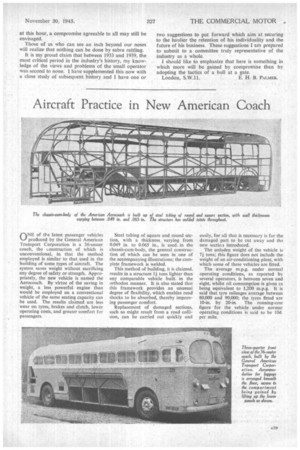Aircraft Practice in New American Coach
Page 39

If you've noticed an error in this article please click here to report it so we can fix it.
ONE of tbe latest passenger vehicles produced by the General American Transport Corporation is a 36-seater coach, the Lonstruction of which is unconventional, in that the method employed is similar to that used in the building of some types of aircraft. The system saves weight without sacrificing any degree of safety or strength. Appropriately, the new vehicle is named the Aerocoach. By virtue of the saving in weight, a less powerful engine than would be employed on a conventional vehicle of the same seating capacity can be used. The results claimed are less wear on tyres, brakes and clutch, lower operating costs, and greater comfort for passengers.
Steel tubing of square and round section, with a thickness varying from 0.049 in. to 0.065 in., is used. in the chassis-cum-body, the general construction of which can be seen in one of the accompanying illustrations; the complete framework is welded.
This method of building, it is claimed, results in a structure I tons lighter than any comparable vehicle built in the orthodox manner. It is also stated that this framework provides an unusual degree of flexibility, which enables road shocks to be absorbed, thereby improving passenger comfort.
Replacement of damaged sections, such as might result from a road collision, can be carried out quickly and
easily, for all that is necessary is for the damaged part to be cut away and the new sectios introduced.
The unladen weight of the vehicle is 7/ tons; this figure does not include the weight of an air-conditioning plant, with which some of these vehicles are fitted.
The average m.p.g. under normal operating conditions, as reported by several operators, is between seven and eight, whilst oil consumption is given as being equivalent to 1,200 m.p.g. It is said that tyre mileages average between 80,000 and 90,000; the tyres fitted are 10-in. by 20-in. The running-cost figure for the vehicle under normal operating conditions is said to be 10d. per mile.




























































